As cold weather, rain, and wind take over this winter, it’s important to consider some best practices for flying your drone in the cold. We have some helpful tips to help you with drone winter maintenance and flight. There are many things you can do to take care of your drone throughout the winter and to preserve its functionality.



Tips for Flying Your Drone in the Cold
This guide to flying your drone in cold, winter weather will cover five topics:
- Battery
- Flight and Visibility
- Cold Weather Gear
- Moisture and Ice
- Camera Settings
Continue reading for helpful cold weather drone flight and maintenance tips.
Battery
Most commercial drones use Lithium Polymer (LiPo) batteries. Extreme temperatures can prevent the LiPo batteries used in your drone from performing optimally. You can find the recommended operating temperature range for your drone inside the operator manual that it came with. When operating at the lower end, or below, the drones operating temperature range, you should take extra steps to ensure a safe flight.
Follow these tips to get the most out of your drone’s battery life during a cold, winter flight:
- Pre-heat your batteries and keep backup batteries warm. A battery heater or battery insulation stickers can help if your product is compatible. Other methods to keep your drone battery warm include keeping them in your pocket or an insulated case.
- Fly with fully charged batteries.
- Keep an eye on your drone’s battery status during flight since it will drain faster during cold weather.

Flight and Visibility
Inclement weather, including thunderstorms, snowstorms, wind shear, icing, and fog, creates potentially hazardous conditions for drone operators. The FAA’s Part 107 rules state that you should maintain a minimum weather visibility of three miles from the control station and always keep your drone in your visual line of sight. This means you’ll need to check the weather before your planned flight.
Follow these tips to fly safely when winter weather might impair visibility.
- Check the weather conditions before you fly. Reschedule your flight if inclement weather is forecasted.
- If you encounter rain, land your drone as soon as it is possible to do so safely. Fog and snow also produce moisture that can damage your drone, so it’s best not to fly when either is present.
- Ensure your GPS signal is strong. This includes making sure your mobile device and controller are charged.
Cold Weather Gear
Not only does your drone need to be in good condition for flying during the winter, but so do you as the operator. That means you should dress appropriately before spending time outdoors in the cold with your drone.
Follow these tips to stay warm while flying your drone in the cold:
- Wear a pair of touchscreen gloves that will keep your fingers nimble and still allow you to use your touchscreen controller and mobile device.
- Bring a pair of sunglasses. Sounds like an odd piece of advice for winter time, but there’s logic here. The white reflective snow can cause a glare that interferes with your line of sight or visibility of your controller.
- Dress in warm layers for outdoor flights. You don’t want to cut your flight short because you need to go back home for a jacket.
Moisture and Ice
Moisture from rain, snow, or fog can damage the motors of your drone. Ice can also cause a problem for the propellers. It’s important to protect your drone from water and moisture.
Follow these tips to protect your drone from moisture and ice:
- Avoid direct contact during takeoff or landing with snow. A landing pad can provide a flat, dry, clean surface for taking off and landing your drone.
- In extremely cold cases, you may need to be prepared for propeller icing. Extreme cold and moisture combined can result in a build-up of ice on the propellers during flight. This can lead to prop damage and even crashing. Avoid flying in temperatures less than 0℃/32℉, and land as soon as possible if you suspect propeller icing.
- After the flight, wipe down the drone with a towel and ensure it’s completely dry before storing it away.

Camera Settings
You can capture the beauty of winter with the right camera settings whether on the ground or in the air. A snowy landscape inspires winter delight in all of us. The trick to capturing beautiful winter photos with your camera drone is adjusting the exposure and white balance settings.
Follow these tips for adjusting your drone camera settings to capture winter photos (you may need to customize these tips to your particular camera and subject matter):
- Manually set your exposure. A general recommendation for photographing snowy landscapes is to over-expose the image by 0.3-0.7 stop and check the results.
- Adjust your white balance settings. The recommended value for photographing snow is 6500k. Take a test shot to determine if you need to increase or lower this value.
If you’ve found these tips for flying your drone in cold weather to be helpful, you can also check out these tips for flying your drone in hot weather.
About UAV Coach

UAV Coach is an sUAS training company that reports on drone industry news to a community of over 50,000 drone enthusiasts around the world. They track global regulations and product launches, offer a Drone Pilot Ground School Part 107 test prep course, and train students how to fly safely and professionally.







